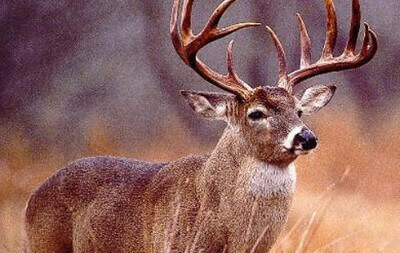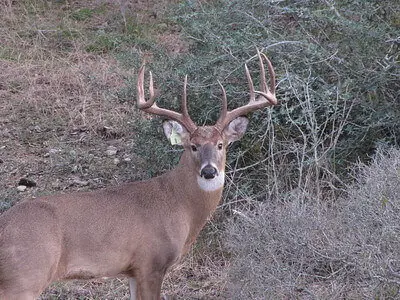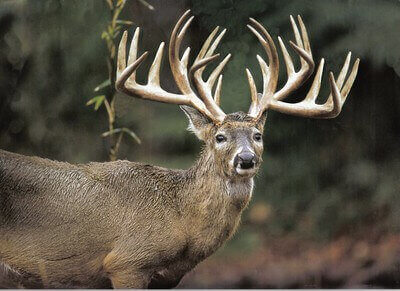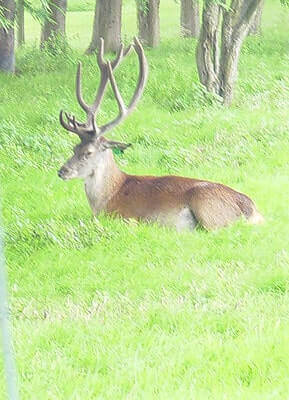Disclosure: We may earn commissions if you purchase products after clicking on a link from our site.
If you’re looking to bag yourself a deer this hunting season, then it’s important to know how to scout for deer. By identifying and understanding the deer’s patterns and habits, you can put yourself in the best position for a successful hunt. In this blog post, we’ll discuss how to scout the area for deer and tips on how to bag your buck!

Table of Contents
How To Scout For Deer
1. Learn To Read Deer Tracks
One of the obvious ways to scout deer is to find their tracks. Yes, you will be making progress if you locate deer tracks, but if you know how to read the tracks, you can glean more information from them. Besides just knowing that deer was in that area, you can get a rough idea about the size, gender, and age of the deer.
Mature bucks’ tracks are larger and go deeper into the soil. Does and young bucks tracks are large with distinct halves. Fawns, on the other hand, leave very small triangle-shaped tracks. If you see dew claw marks, it is either the ground at the time was soft and muddy or it was a buck who left the impression. You could be on the trail of a buck!
Moreover, from the tracks, you can also determine which direction it is headed as sharp tips usually point forward. You can also determine if it left in a hurry or not. A deer that was on the run will leave tracks that sunk deeper and be spaced a few feet apart. A deer that was walking will have tracks that are spaced every couple of feet. How to scout for deer is similar to scouting for many other game animals. Look for signs of deer life.
2. Deer Poop & Scat
You can learn a lot from the poop and scat of deer. Deer feed on branches during the fall and winter. Branches are rich in fiber and this creates poop that is pellet-shaped. This means that they are in young brushy forests with many branches that they can easily reach. You can locate those areas and set up a ground blind or climbing treestand. We reviewed the best climbing tree stands and you can read them from this link.
Additionally, if their poop is looser and has watery clumps of pellets, this indicates their diet consisted mainly of green plant material. You can also search for areas with lush green vegetation to locate whitetail deer. Moreover, you can use their scat as your guide if you lose sight of their tracks. How to scout for deer involves keeping your eyes out for obvious deer signs.
3. Deer Beds
Learning to identify deer beds can give you a lot of information to track them down. The deer bed makes a simple oval or kidney-bean shape on the ground. It is more pronounced during winter in the snow, but it can also be seen during the summer in grassy areas. If you find a single large bed, that is probably that of a mature buck. Several beds can mean that those are doe and fawns.
Deer lies in bedding areas during the day and are more active at night. If you stumble across many smaller beds, that could mean that does and fawns are in that area during the day. Bucks will start to move downwind of those bedding areas as it get closer to the rut. You can use that information to set up and wait for the mature buck as he searches for does when the rut begins.

4. Deer Rubs
When you are scouting for deer, keep your eyes open for rub lines. Bucks will rub trees along the way when they move between bedding and feeding areas. These rub lines indicate a corridor that they move in and it gives an idea of where they go and how they got there. A fresh rub line coming out of an area will be worth investigating and hunting. Tracking deer involves understanding their behaviors and spotting signs of it.
5. Scrapes
When scouting for deer, look out for scrapes. Scrapes are small portions of the ground, usually a three-foot oval area, that the deer will create by removing the leaves and debris. After removing the leaves and debris, the whitetail will urinate on the spot. They use the scrape to communicate using their urine. Bucks use the scrape to also convey their social dominance status as well as their breeding status. Does communicate by also urinating in the scrape.
6. Deer Browse
Deer browse can identify possible feeding areas. Deer sandwich branches between their bottom incisors and palette at the top. They then rip off the vegetation. This is deer browse. If you find areas with fresh browse, you can set up a tree stand in that area to look out for deer. How to hunt from a tree stand is discussed in this article.
7. Wind Direction
Always be mindful of the wind direction. Deer have a very good sense of smell. Always be downwind of where you think the deer will be located so they don’t pick up your scent.
Understanding wind direction is paramount when scouting for deer as it significantly impacts your ability to remain undetected while hunting. Deer rely heavily on their sense of smell to detect potential threats, and wind direction can carry human scent directly to their sensitive noses, alerting them to danger and causing them to flee.
By knowing the wind direction, hunters can strategically position themselves downwind from areas where deer are likely to be present, minimizing the risk of being detected.
Additionally, being aware of prevailing wind patterns can help hunters choose optimal stand locations and approach routes, maximizing their chances of encountering deer without being detected. Overall, prioritizing knowledge of wind direction enhances a hunter’s stealth and increases their likelihood of success when scouting for deer.

8. Food Sources
Locating food sources is a crucial aspect of scouting for deer, as deer are primarily driven by the availability of food when selecting their habitat. During scouting, it’s essential to identify areas with abundant food sources such as agricultural fields, food plots, orchards, and natural browse like acorns, fruits, and vegetation.
These food sources serve as magnets for deer activity, attracting them to specific areas during different times of the year. By pinpointing these food-rich locations, hunters can strategically plan their hunts and set up ambush points near these areas to increase their chances of encountering deer.
Additionally, understanding the seasonal variations in food availability can help hunters anticipate deer movement patterns and adjust their hunting strategies accordingly. Overall, identifying and monitoring food sources play a vital role in successful deer scouting and hunting endeavors.
9. Local Folks
Talking to local people in the area you want to scout for deer can provide invaluable insights and knowledge about deer behavior, habitat preferences, and movement patterns specific to the area.
Locals, such as farmers, landowners, and long-time residents, often have firsthand experience observing deer in the area and can offer valuable information about deer sightings, travel corridors, bedding areas, and feeding locations.
They may also share tips on prime hunting spots, and areas with high deer populations, and even offer access to private lands for hunting. Engaging with the community fosters goodwill and may open doors to opportunities that would otherwise be inaccessible.
Additionally, locals may provide information on potential hazards, hunting regulations, and local customs that can enhance your scouting experience and contribute to a safer and more productive hunt. Overall, tapping into the knowledge of residents is an essential step in thorough deer scouting and can significantly increase your chances of success in the field.
10. Edges & Transition Lines
Deer loves edges of overgrown clear-cuts, densely covered vegetation, and ugly swamp bottoms. If you can locate these edges and watch those areas, you may find deer there. They also like areas where two different habitats meet; and break in habitat.
When scouting for deer, it’s crucial to pay close attention to edges and transition lines, as these areas often serve as natural travel routes and habitat boundaries for deer. Edges are where different types of habitat meet, such as where fields meet forests, or where a creek cuts through woodland.
These transitional zones provide diverse food sources, cover, and security, making them attractive to deer. Look for signs like tracks, droppings, rubs, and trails along these edges, as deer are likely to frequent them during their daily movements.
Additionally, edges offer prime locations for setting up hunting stands or blinds, as they provide clear sightlines and increased opportunities for encounters with deer. By focusing on edges and transition lines during scouting, hunters can gain valuable insights into deer behavior and habitat use, ultimately increasing their chances of success during the hunting season.
The Bottom Line
How to scout for deer is an important skill to learn as a hunter. Scouting is an important part of hunting and when you learn how to scout for deer, you will be rewarded handsomely. In this article, we discussed how to scout for deer to help you be successful in landing that buck. Hunting deer involves a lot of skills, planning, and strategy.
In this article, we discussed the best whitetail deer hunting tips. How to scout for deer is not difficult as it may seem. There are some deer signs that you should be looking for that will indicate their activity in the area, like deer tracks, poop, and scat. You can also read how to scout for ducks, how to scout turkeys, how to attract deer, how to hunt deer at night, how to scout the hunting ground, best deer feeders, and the best deer drags.
